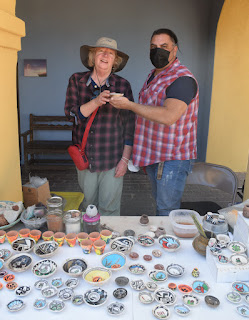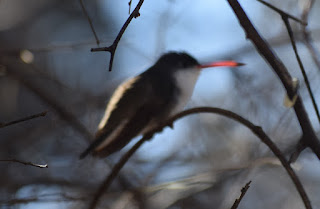Monday we left Tubac and went North on I-19, went east on a regular highway, and picked up I-10 east. We continued to the Hatch cutoff, and stopped in Hatch for lunch at B & E Burritos. We stopped into one of dozens of chili shops in Hatch, and bought some powdered chile. The Clerk told us that most people in Hatch are Mexicans, who work in the fields up and down the Rio Grande. We continued north on I-25 to Bosque Birdwatchers RV park, which was almost a 400 mile day. We dropped the rig and drove over to the viewing area, but did not see the thousands of Sandill Cranes that we had hoped for. The next morning we were there at dawn, and watched hundreds of snow geese, including some “blue morph” geese, who have dark bodies instead of the white of snow geese.
 |
| Sunset at Bosque de Apache National Wildlife Refuge |
Tuesday we headed to nearby Socorro, where we visited the New Mexico Tech mineral museum, which had a bewildering collection of rocks, meteorites, petrified wood, and mining paraphernalia. The lady in the gift shop helped Sandi buy some rock books and small rocks for Jack. We stopped by the mission church, which recently celebrated their 400th year anniversary, but it was locked.
We continued on to Albuquerque, where we enjoyed the Indian Pueblo Cultural Center. Richard had been there years before, but the exhibits had been totally redesigned. Richard had a lengthy conversation with Jon Ghahate, who answered the “tribe or pueblo” question in a very roundabout way. He pointed out that the concept of nation states really dates from the 1700s, and the US was arguably the first nation state, as opposed to kingdom or city-state. The Spaniards referred to the indian villages as “Pueblos”, which is the Spanish word for cities. The Indians did not refer to themselves that way; each tribe had its own name for itself, in their native language. The Indian languages did not have a word that referred to all the Indians. Sandi bought some earrings from an indian from Santo Domingo Pueblo.
We continued on to Santa Fe, where we camped at the Rancheros de Santa Fe, which is open in a very limited way during the winter months, but does have excellent wifi. Sandi had work to do and needed good wifi.
Wednesday we drove to Las Vegas, New Mexico, where we visited the Plaza hotel on the main plaza. When we stopped in the World Treasures Travelers Cafe, we found many weavings hanging, and a couple of looms; we spoke at length to Teresa, whose mother had run a weaving co-operative. We saw her later on the street, speaking to another lady about a filming that was to be done that day. Las Vegas is better preserved than most towns, and is often used as a setting for movies. At one point it was a railroad hub, and the largest town in New Mexico.
We then went to visit the Castaneda Hotel, next to the railroad, which was a Harvey House hotel. A developer had bought the Plaza and Castaneda Hotels and brought them back to their former glory.
We stopped in Raton, where Sandi took a business call. I walked around and visited the local museum. Raton seemed very run down, mostly empty storefronts, quite different than Las Vegas. We continued over Raton Pass to Trinidad Lake State Park, where we had a camping reservation. The news from Northern Colorado was about an ice storm that hit Wednesday AM, so we wanted to let the ice melt before we headed home.
Thursday we drove home, stopping in Colorado Springs for lunch and gas. We arrived home mid-afternoon.

















